Wetland Restoration: What they are, why they’re important, pre-existing conservation efforts, and potential restoration techniques.
Importance of Wetlands: What are Wetlands?
Wetlands are regions covered by water, usually between aquatic and terrestrial ecosystems. Some are flooded with water year long while others are only flooded seasonally–either way, saturated (hydric) soils are a key determinant in the fauna of wetland ecosystems (hydrophytes).
Types of Wetlands
Marshes: These wetlands are usually flooded and found at the edges of rivers or lakes. Emergent marshes have shallow water and are almost completely covered in emergent (floating) plants. Hemi-marshes have deeper water with a mix of emergent and submerged plants.
Sedge meadows: These wetlands are wet grasslands with soils that are almost always saturated, found in transitional zones, wet depressions, swales, or areas of groundwater discharge.
Wet Prairies: These wetlands are medium saturated and often found between sedge meadows and mesic prairies, making them one of the driest types of wetlands.
Fens and Seeps: Fens have an alkaline pH due to groundwater with a peat layer (from dead plant matter) as well as grasses, trees, and shrubs. Seeps are found at glacial moraines or slope bases with spring water.
Bogs: These wetlands rely on precipitation for saturation (not groundwater or streams), are cool in temperature, low in nutrients, and low in oxygen.
Swamps: These wetlands are dominated by trees or shrubs (forested swamps versus shrub swamps) in standing water in low-elevation floodplains with high nutrient levels.
How Wetlands Benefit Humans
One of the key ecosystem services of wetlands is flood protection. Wetlands–with their rich vegetation–are able to retain and store runoff, precipitation, surface water, and groundwater before gradually releasing it, reducing not only flooding but erosion, too. These are especially important in regions with high levels of runoff, such as near urban areas where paving and buildings create higher rates and volumes of surface runoff. Wetlands act as the natural equivalent of dredges or levees except with the added benefit of increased biodiversity and eco-services. As water moves through wetland vegetation, pollutants and nutrients are filtered out and improve water quality, which is particularly crucial for drinking water. In addition, wetlands help humans economically through recreation, aesthetic value, and the harvest of fish, shellfish, blueberries, cranberries, timber, rice, and even medicines.
How Wetlands Benefit the Environment
Wetland ecosystems are nearly on par with tropical rainforests and coral reefs in terms of biodiversity and species richness thanks to high levels of nutrients, primary productivity, and detritus: small particles of dead plant matter that feed small prey species that form the base of the food chain. Wetlands are also highly efficient carbon sinks, meaning that they store carbon in their vegetation and help moderate climate change. Several fish, migratory birds, and mammals depend on wetlands for survival whether it be for feeding, breeding, or mating, not to mention that one third of endangered species in the US rely solely on wetlands for habitat. From striped bass and blue crabs to otters and black bears to peregrine falcons and raccoons, wetlands are vital ecosystems for a plethora of species as well as the overall environment.
Conservation Efforts
Regulatory Restoration: Protection efforts that are required by local, state, or federal law are considered regulatory restoration. Alongside the Clean Water Act and Safe Drinking Water Act, regulatory regulation uses compensatory mitigation with the goal of rehabilitating, enhancing, creating, or preserving wetlands; modes of compensatory mitigation include mitigation banks, fee programs, and permittee-responsible mitigation.
Voluntary Restoration: Restoration efforts that are not regulated or required by law are considered voluntary regulation, which is what states and tribes tend to rely on. This often involves joint efforts between nonprofit organizations, local governments, and industries with a less narrowed focus on simply improving the functioning of wetland ecosystems. Partnering with independent groups or programs may involve engineering constructed treatment wetlands to recreate the effects of wetland plants, soils, and microbes and their water quality-improving traits instead of building far more costly stormwater treatment facilities.
Restoration Techniques
Backfill Ditches: Dredging land and placing the dredged material along ditches as spoil banks helps with irrigation and water movement by preventing sheetflow and promoting stream and channel flow, which in turn helps restore topography.
Construct Berms: Berms–flat land strips or embankments used for flood protection–or dikes can protect the adjacent land and property from natural flooding.
Control Weeds: Weeds and other invasive vegetation can be removed by hand, by machine, or by herbicides (as well as grazers and pathogens). Examples include prescribed fires to subdue weed growth and help native plant growth as well as solarizing and killing invasive grasses with black plastic.
Excavation: Digging up the ground via excavation can help even the elevation and reach groundwater to help saturate new wetlands, albeit this is a difficult and expensive approach to wetland restoration.
Install Water Control Structures: Artificially managing water levels can be a great help in restoring hydrology by implementing plastic or metal risers and stoplog structures to regulate water flow or using emergency spillway troughs to prevent flooding. However, these structures can be high maintenance and disrupt the movement of fish.
Reconnect Floodplains & Restore Backwaters, Channels, and Bends: Connecting straightened streams to their original meanders and channels by removing dikes and levees can decrease sediment loading and downstream flooding as well as raise the water table levels, decrease water temperatures, and restore fish populations (fish use meanders as nurseries).
Remove Culverts: Culverts–drainage pipes or tunnels built under roads–often harm fish populations by trapping debris and restricting water flow and blocking fish pathways or causing hypersalinity. By removing them, many plant and fish populations would be saved.
Remove Tile: One of the simplest wetland restoration techniques is tile breaking: removing underground field tiles that drain wetlands. The tiles are made of clay or plastic and are connected to downstream pipes that ultimately help maintain wetland hydrology.
Photo by Tyler Butler on Unsplash
Written by Carole Wilay (’25)

